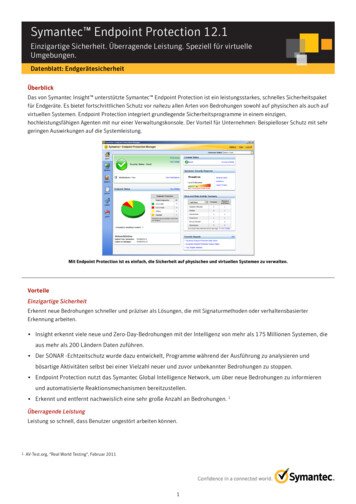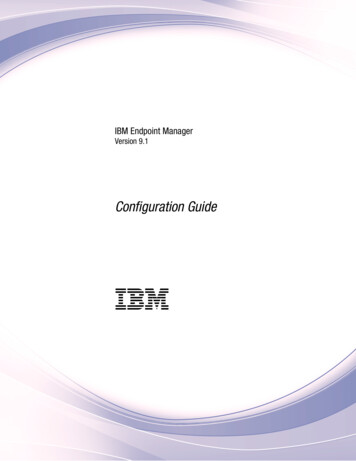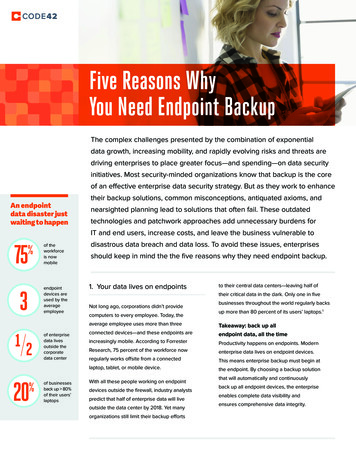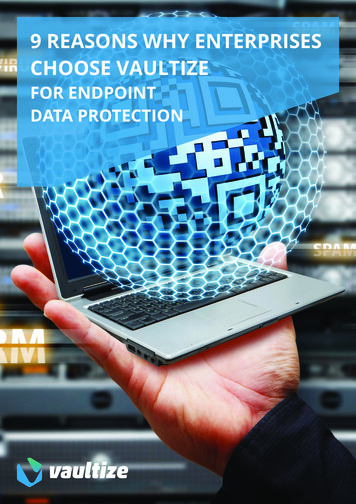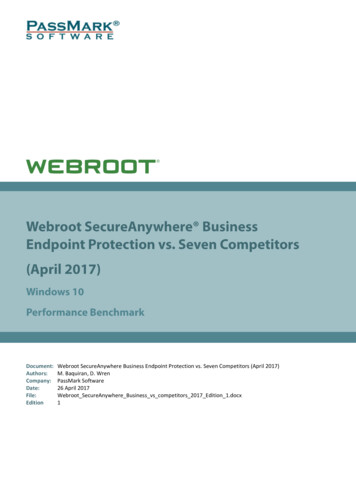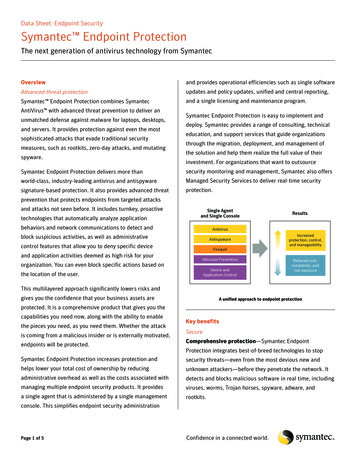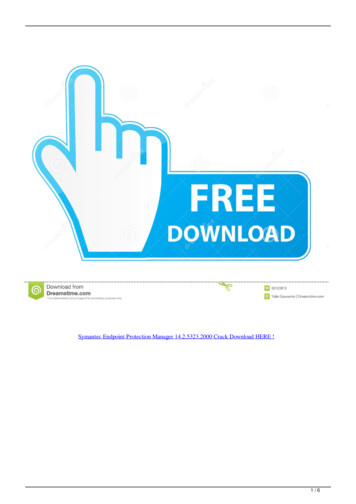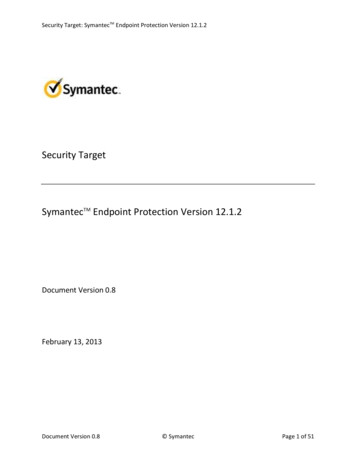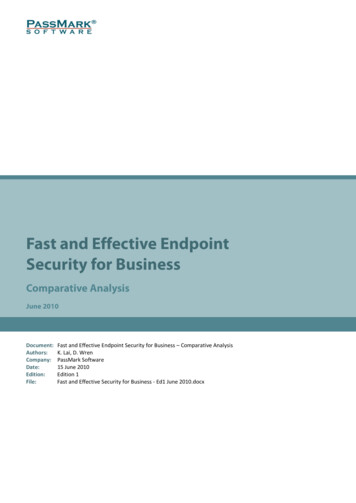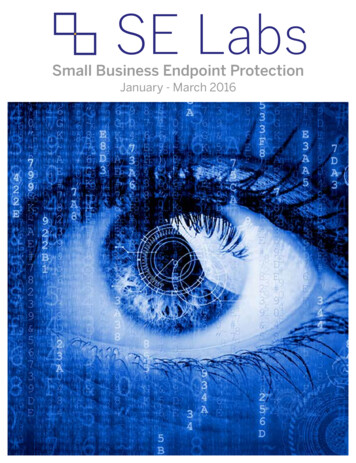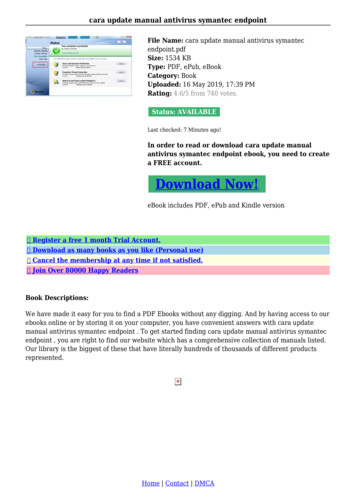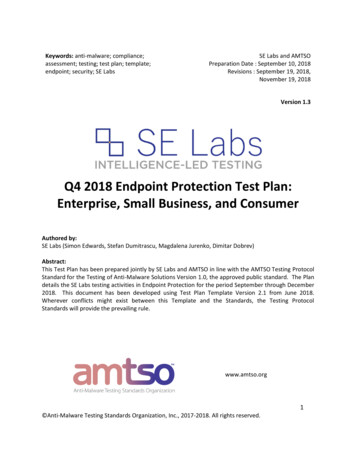
Transcription
Keywords: anti-malware; compliance;assessment; testing; test plan; template;endpoint; security; SE LabsSE Labs and AMTSOPreparation Date : September 10, 2018Revisions : September 19, 2018,November 19, 2018Version 1.3Q4 2018 Endpoint Protection Test Plan:Enterprise, Small Business, and ConsumerAuthored by:SE Labs (Simon Edwards, Stefan Dumitrascu, Magdalena Jurenko, Dimitar Dobrev)Abstract:This Test Plan has been prepared jointly by SE Labs and AMTSO in line with the AMTSO Testing ProtocolStandard for the Testing of Anti-Malware Solutions Version 1.0, the approved public standard. The Plandetails the SE Labs testing activities in Endpoint Protection for the period September through December2018. This document has been developed using Test Plan Template Version 2.1 from June 2018.Wherever conflicts might exist between this Template and the Standards, the Testing ProtocolStandards will provide the prevailing rule.www.amtso.org1 Anti-Malware Testing Standards Organization, Inc., 2017-2018. All rights reserved.
Table of Contents1.Introduction . 32.Scope . 33.Methodology and Strategy . 44.Participation . 55.Environment . 66.Schedule . 77.Control Procedures . 88.Dependencies . 89.Scoring Process . 810.Dispute Process . 911.Attestations . 102 Anti-Malware Testing Standards Organization, Inc., 2017-2018. All rights reserved.
SE Labs Test Plan for Q4 2018 Endpoint Protection1.IntroductionSE Labs tests a variety of endpoint security products from a range of well-known vendors in aneffort to judge which were the most effective. Each enterprise, small business, or consumerclass product are exposed to the same threats, which are a mixture of targeted attacks usingwell-established techniques, public email, and web-based threats that are known or found to belive on the internet at the time of the test. The Test Reports indicate how effectively theproducts were at detecting and/or protecting against those threats in real time. The mostrecent quarterly reports for each class of application are listed oad/small terprise.pdf2.ScopeThe SE Labs Endpoint Test examines applications from the enterprise, small business, andconsumer sector with the following companies and software products composing the latesttests.VendorCrowdstrikeESETKaspersky LabMalwarebytesMcAfeeMicrosoftSophosSymantecTrend ersky LabMcAfeeENTERPRISE PRODUCTSProductCrowdstrike FalconESET Endpoint SecurityKaspersky Endpoint SecurityMalwarebytes Endpoint SecurityMcAfee Endpoint SecurityMicrosoft System Center Endpoint ProtectionIntercept X AdvancedSymantec Endpoint Security Enterprise EditionTrend Micro OfficeScan, Intrusion Defense FirewallAntivirus for BusinessSMALL BUSINESS PRODUCTSProductBitdefender Gravity Zone Endpoint SecurityCrowdstrike FalconESET Endpoint SecurityKaspersky Small Office SecurityMcAfee Small Business3 Anti-Malware Testing Standards Organization, Inc., 2017-2018. All rights reserved.
MicrosoftSophosSymantecTrend MicroWebrootMicrosoft System Center Endpoint ProtectionIntercept X AdvancedSymantec Endpoint Protection CloudTrend Micro Worry Free Security ServicesWebroot SecureAnywhere EndpointCONSUMER PRODUCTSVendorProductAVASTAvast Free AntivirusAVGAVG Antivirus Free EditionAviraAvira Free Security SuiteESETESET Smart SecurityF-SecureSecureSafeK7K7 Antivirus PremiumG-DataG-Data Internet SecurityKaspersky LabKaspersky Internet SecurityMcAfeeMcAfee Internet SecurityMicrosoftWindows DefenderSymantecNorton SecurityTrend MicroTrend Micro Internet SecurityQuickhealQuickheal Internet SecurityWebrootWebroot Antivirus3.Methodology and StrategyTest Framework - The test framework collects threats, verifies that they will work againstunprotected targets and exposes protected targets to the verified threats to determine theeffectiveness of the protection mechanisms.Threat Management Systems (TMS) - The Threat Management System is a database of attacksincluding live malicious URLs; malware attached to email messages; and a range of other attacksgenerated in the lab using a variety of tools and techniques. Threats are fed to the ThreatVerification Network (TVN).Threat Verification Network (TVN) - When threats arrive at the Threat Verification Networkthey are sent to Vulnerable Target Systems in a realistic way. For example, a target would loadthe URL for an exploit-based web threat into a web browser and visit the page; while its emailclient would download, process and open email messages with malicious attachments,downloading and handling the attachment as if a naïve user was in control. Replay systems areused to ensure consistency when using threats that are likely to exhibit random behaviors andto make it simpler for other labs to replicate the attacks.Target Systems (TS) - Target Systems (TS) are identical to the Vulnerable Target Systems used onthe Threat Verification Network, except that they also have endpoint protection softwareinstalled.4 Anti-Malware Testing Standards Organization, Inc., 2017-2018. All rights reserved.
Threat Selection - All of the following threats are considered valid for inclusion in the test,although the distribution of the different types will vary according to the test’s specific purpose: Public exploit-based web threats (exploitation attacks)Public direct-download web threats (social engineering attacks)Public email attachment threats (exploitation and social-engineering attacks)Private exploit-based web threats (exploitation attacks)Private direct-download web threats (social engineering attacks)Private email attachment threats (exploitation and social-engineering attacks)Public threats are sourced directly from attacking systems on the internet at the time of the testand can be considered ‘live’ attacks that were attacking members of the public at the time ofthe test run. Multiple versions of the same prevalent threats may be used in a single test run,but different domain names will always be used in each case. Private threats are generated inthe lab according to threat intelligence gathered from a variety of sources and can beconsidered as similar to more targeted attacks that are in common use at the time of the testrun.All threats are identified, collected and analyzed independently of security vendors directly orindirectly involved in the test. The full threat sample selection will be confirmed by the ThreatVerification Network as being malicious. False positive samples will be popular and nonmalicious website URLs as well as applications downloaded directly from their source websiteswhere possible.4.ParticipationSE Labs no longer charge for testing so there are no contracts to be considered in this section.This is a new business policy for 2018 and details can be discussed with SE Labs directly.Test subjects adopting full participation status at rates listed below have been typical. Business Tests : 75% Participants, licenses provided for testing, post-test consultingservices utilized. Consumer Tests : 29% Participants, licenses provided for testing, post-test consultingservices utilized with the others either neutral or unaware of the test itself.The general process for participation in this, or any, test with SE Labs follows. SE Labs or Vendor approach one another in person, by email or on the phone.Both parties will then :o Discuss the desired testing methodology and configurationo SE Labs reserves the right that they may or may not test the producto Dispute processes precedeo Report publicationPlease contact us at info@SELabs.uk. We will be happy to arrange a phone call to discuss ourmethodology and the suitability of your product for inclusion.5 Anti-Malware Testing Standards Organization, Inc., 2017-2018. All rights reserved.
Opt-Out Policy : If any Vendor can supply sufficient reason as to why SE Labs should not includetheir product in an upcoming or on-going test, SE Labs will honor that request provided thatthere is agreement on the facts. As an example, an acceptable Opt-Out request would includethe documented and pending release of a substantially new version of Vendor software whichwould render the testing the previous version meaningless.Conflict of Interest Disclosure : No known conflicts of interest exist at this time. Post-testconsultancy services are available to all participants for a fee.Funding : Products we consider of key interest to our readers are included in our tests at no costto the vendor. Post-test consultancy services, rights to use our logos, and re-promote ourresults are made available to all participants, subject to consultancy or licensing fees.5.EnvironmentPhysical Configuration : The Target Systems are identical Windows PCs specified as below. Eachsystem has unrestricted internet access and is isolated from other Target Systems using VirtualLocal Area Networks (VLANs). Each system runs Windows 10 (64-bit), updated with securitypatches available up to Creators Update (Fall 2017). The general Target System specificationincludes Windows PCs with an Intel Core i3-4160 3.6GHz processor, 4GB RAM, and a 500GB7200rpm SATA hard disk.Popular but vulnerable third-party applications installed include Adobe Flash Player, AdobeReader, Apple QuickTime and Oracle Java (32-bit). If a security product requires an updated filefrom Microsoft the tester will install the necessary file. A web session replay system will be usedwhen exposing systems to web-based threats. This provides an accurate simulation of a liveinternet connection and allows each product to experience exactly the same threat. All productshave real-time and unrestricted access to the internet.Sample Relevance (SE Labs criteria defining legitimate sample selection) - Non-maliciouswebsite URLs and application files are used to check for false positive detection. The number ofthese URLs and files will match the number of malware samples used. Candidates for legitimatesample testing include newly released applications, ranging from free software to the latestcommercial releases. Potentially unwanted programs, which are not clearly malicious but thatexhibit dubious privacy policies and behaviors, will be excluded from the test.Curation Process : Malicious URLs and legitimate applications and URLs were independentlylocated and verified by SE Labs. Targeted attacks were selected and verified by SE Labs. Theywere created and managed by Metasploit Framework Edition using default settings. The choiceof exploits was advised by public information about ongoing attacks. One notable source wasthe 2016 Data Breach Investigations Report from Verizon.Details regarding Test Threat Selection and Management follow. Sample numbers and sources - The Target Systems will be exposed to a selection ofthreats. These are weighted heavily ( 75 per cent) towards public web-based threats. Asmaller set of the samples will include public threats attached to emails and private,targeted attacks delivered by web exploitation or as email attachments. There may also6 Anti-Malware Testing Standards Organization, Inc., 2017-2018. All rights reserved.
be some threats found via alternative routes, such as internet messaging (IM) or peer topeer (P2P) networks. Sample verification - Threats will be verified using Vulnerable Target Systems. Threatverification occurs throughout the test period, with live public threats being used shortlyafter they are verified as being effective against the Vulnerable Target Systems on theThreat Verification Network. In cases where a threat is initially verified to be effective,but which is found not to be effective during testing (e.g. its C&C server becomesunavailable), the threat sample will be excluded from the test results of each product. Attack stage - Threats will be introduced to the system in as realistic a method aspossible. This means that threats found as email attachments will be sent to targetsystems in the same way – as attachments to email messages. Web-based threats aredownloaded directly from their original sources. These downloads occur through aproxy system that includes a session replay service to ensure consistency. Public threatsthat run on the Target System are allowed 10 minutes to exhibit autonomous maliciousbehavior. This may include initiating connections to systems on the internet or makingchanges to the system to establish persistence.Distribution of Test Data : Malicious and legitimate data will be provided to partnerorganizations once the full test is complete. SE Labs does not share data on one partner withother partners. We do not currently partner with organizations that do not engage in ourtesting. Any security vendor that has their product tested may request hashes of their missedsamples.6.ScheduleStart Date Range : Test configuration is scheduled to take place from September 10th, 2018through September 21st, 2018. Test commencement is forecast for September 24th, 2018.Participant configuration is anticipated to take place during the intervening two week period.Test Duration and Calculated End Date : The final Test Report is anticipated during the week ofDecember 10th, 2018.Milestones : Interim schedule milestones are listed below.Sample Schedule Summary for Test ProjectIndexTest ActivityStart Date Range1Test CommencementSept 24, 20182Confirm VendorConfiguration FeedbackSept 10-21, 20183Milestone 1 – PreliminaryResultsTBDDependencies(1), (2)7 Anti-Malware Testing Standards Organization, Inc., 2017-2018. All rights reserved.
4Milestone 2 – Test ReportFirst Edition – End ofTesting PeriodNovember 23, 2018(3)5Feedback and DisputeResolution Time – Retestsas NeededNovember 23, 2018 –December 7, 2018(4)6Milestone 3 – Issue FinalReport – End Date for TestDecember 10, 2018 –December 14 ,2018(5)Communications : All Participants will be notified when the schedule wanders by four week ormore.Risks and Risk Management : No additional risks are known at this time.7.Control ProceduresConnectivity Validation : Automatic submission of data to vendors is disabled where possibleunless this reduces the immediate effectiveness of the product. A means for confirming whethera Product’s cloud connectivity or other features are functioning can be provided by the Vendor.Logging : Products run with the default settings. Additional logging may be enabled if requestedby the vendor of the product in question. Vendors of business software are invited to makeconfiguration recommendations.Updates : All products are updated fully using the latest definitions, patches and any otheravailable updates. These updates are made immediately prior to each exposure to a threat orlegitimate application. Products may be upgraded to the latest version, if the version changesduring the test period.8.DependenciesParticipant and Test Subject Vendors Required Actions : Vendors may contact SE Labs forinclusion, exclusion or to respond to an invitation, either accepting or declining.9.Scoring ProcessThe following occurrences during the attack stage will be recorded and all contribute to theproduct effectiveness measure. The point of detection (e.g. before/after execution).Detection categorization, where possible (e.g. URL reputation, signature or heuristics).Details of the threat, as reported by the product (e.g. threat name; attack type).Unsuccessful detection of threats.Legitimate files allowed to run without problems.8 Anti-Malware Testing Standards Organization, Inc., 2017-2018. All rights reserved.
Legitimate files acted on in non-optimal ways (e.g. accusations of malicious behavior;blocking of installation) and at what stage (e.g. before/after execution).User alerts/interaction prompts such as:o Pop-up information messages (even if not interactive).o Requests for action (take default option or follow testing policy of ‘naïve user’ ifno default provided).o Default suggestions.o Time-out details (e.g. record if an alert/request for action disappears/takes adefault action after n seconds of no user response).When an initial attack or attacker succeeds in downloading further malicious files, suchdownloads will be recorded along with the product’s behavior (if any). This additionaldata will be presented alongside the main results, clearly labeled as representing a SELabs Endpoint Anti-Malware Testing Methodology second attack. For statisticalpurposes, detection rates of these files will not be automatically added to the overalltotals for each product (although doing so after the event will be possible).Any anomalies (e.g. strange or inconsistent behavior by the product).Measuring Product Effectiveness : Each Target System is monitored to detect a product’s abilityto detect, block or neutralize threats that are allowed to execute. Third-party software recordseach Target System’s state before, during and after the threat exposure stage. These resultsshow the extent of an attacker’s interaction with the target and the level of remediationprovided by the product being tested. The same level of monitoring occurs when introducinglegitimate URLs and files when assessing false positive detection rates.Awards : SE Labs provides badges such as AAA, AA, and others based on the Test Scoring results.Partners can use the SE Labs awards logos for marketing purposes.10.Dispute ProcessThe dispute process runs for two weeks from the end of the test. Please see Section 6 coveringthe Test Schedule for additional details and timing. The general Dispute Process works asfollows.1. Results are provided with hash values associated with any sub-optimal results.2. Vendor responds within two weeks, arguing why some results are wrong.3. Tester replies, accepting or denying the dispute.Although discussions will follow, ultimately the data speaks for itself. The most closely argueddisputes are over PUAs in false positive testing, where a file might be legitimate, do no harm,but does appear to contain a library with the potential for unwanted behavior. In such cases avendor might detect it and argue that it's not an FP. In such cases we always remove theapplication from the test set.9 Anti-Malware Testing Standards Organization, Inc., 2017-2018. All rights reserved.
11.AttestationsI understand and agree that I am submitting this Test Plan, and the following Attestations, onbehalf of the entity listed below, and I represent and warrant that I have authority to bind suchentity to these Attestations. All references to “I” or “me” or similar language refer to such entity.I represent and warrant that the following Attestations are true, to the best of my knowledgeand belief, and each of the following commitments will be upheld to the best of my ability.1. I will provide public notification on the AMTSO website covering my obligation fornotification of a Public Test, regardless of whether a potential Participant is in actualreceipt of such notification prior to the Commencement Date of a Test. (Section 1,Section 4, Section 6)2. All products included in this Test will be analyzed fairly and equally. (Section 2, Section3, Section 5)3. I will disclose any anticipated or known imbalance or inequity in the Test design to allParticipants in the Test. (Section 2, Section 3)4. Although I may charge for participation in a Test, I will not charge any additional fees fora Test participant to be “Voluntary” under the Standards. (Section 4)5. I will disclose any material conflicts of interest or other information that could materiallyimpact the reliability of the Test. (Section 4)6. I will disclose how the Test was funded. (Section 4)I hereby affirm, to the best of my knowledge and belief that this Test Plan complies with theAMTSO Testing Standards, as of the date hereof.Signature: /s/ Simon EdwardsName: Simon EdwardsTest Lab: SE LabsAMTSO Test ID: [AMTSO-LS1-TP004]10 Anti-Malware Testing Standards Organization, Inc., 2017-2018. All rights reserved.
AVAST Avast Free Antivirus AVG AVG Antivirus Free Edition Avira Avira Free Security Suite ESET ESET Smart Security F-Secure SecureSafe K7 K7 Antivirus Premium G-Data G-Data Internet Security Kaspersky Lab Kaspersky Internet Security McAfee McAfee Internet Security Microsoft Windows Defender Symantec Norton Security
